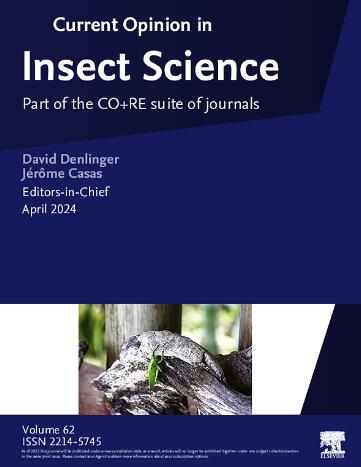寄生虫的种类和多样化。
IF 4.8
1区 农林科学
Q1 BIOLOGY
引用次数: 0
摘要
寄生蜂很可能是地球上物种最丰富的动物群体,寄主与寄生蜂之间的相互作用也可能因此成为最常见的物种相互作用类型之一。了解寄生蜂多样化的主要机制应该是当务之急,尤其是为了预测目前观察到的高灭绝率所带来的后果。解释寄主相关多样化的两个主要假说是 "逃逸与辐射假说 "和 "振荡假说",前者假定关键的创新是辐射爆发的主要驱动力,而后者则假定多样化取决于影响寄主利用的长期遗传变异过程。本文根据这些主要假说回顾了最近关于寄生虫物种变异的文献,以确定潜在的关键创新和寄主利用变异是物种多样化的基础。本文还借鉴了植物-蝴蝶相互作用这一类似系统的最新理论进展,为解释寄生蜂高度多样性的理论发展提供了捷径。本文章由计算机程序翻译,如有差异,请以英文原文为准。
Parasitoid speciation and diversification
Parasitoid wasps may well be the most species-rich animal group on Earth, and host–parasitoid interactions may thereby be one of the most common types of species interactions. Understanding the major mechanisms underlying diversification in parasitoids should be a high priority, not the least in order to predict consequences from high extinction rates currently observed. The two major hypotheses explaining host-associated diversification are the escape-and-radiate hypothesis and the oscillation hypothesis, where the former assumes that key innovations are major drivers of radiation bursts, whereas the latter rather assumes that diversification depends on processes acting on the standing genetic variation that influences host use. This paper reviews the recent literature on parasitoid speciation in light of these major hypotheses to identify potential key innovations and host use variability underlying diversification. The paper also calls upon recent theoretical advances from a similar system, plant–butterfly interactions, to provide shortcuts in the development of theories explaining the high diversity of parasitoid wasps.
求助全文
通过发布文献求助,成功后即可免费获取论文全文。
去求助
来源期刊

Current opinion in insect science
BIOLOGYECOLOGYENTOMOLOGY-ECOLOGY
CiteScore
10.40
自引率
1.90%
发文量
113
期刊介绍:
Current Opinion in Insect Science is a new systematic review journal that aims to provide specialists with a unique and educational platform to keep up–to–date with the expanding volume of information published in the field of Insect Science. As this is such a broad discipline, we have determined themed sections each of which is reviewed once a year.
The following 11 areas are covered by Current Opinion in Insect Science.
-Ecology
-Insect genomics
-Global Change Biology
-Molecular Physiology (Including Immunity)
-Pests and Resistance
-Parasites, Parasitoids and Biological Control
-Behavioural Ecology
-Development and Regulation
-Social Insects
-Neuroscience
-Vectors and Medical and Veterinary Entomology
There is also a section that changes every year to reflect hot topics in the field.
Section Editors, who are major authorities in their area, are appointed by the Editors of the journal. They divide their section into a number of topics, ensuring that the field is comprehensively covered and that all issues of current importance are emphasized. Section Editors commission articles from leading scientists on each topic that they have selected and the commissioned authors write short review articles in which they present recent developments in their subject, emphasizing the aspects that, in their opinion, are most important. In addition, they provide short annotations to the papers that they consider to be most interesting from all those published in their topic over the previous year.
 求助内容:
求助内容: 应助结果提醒方式:
应助结果提醒方式:


